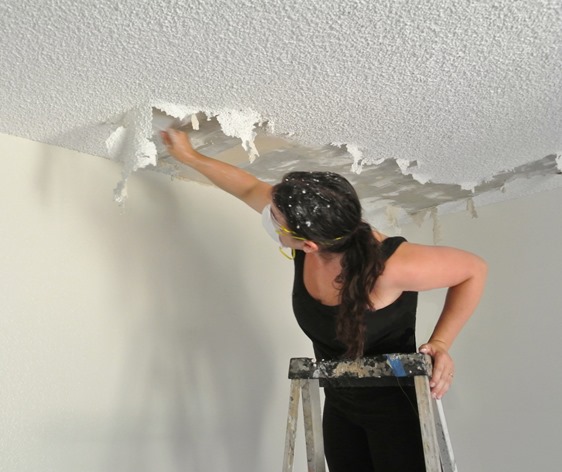The ‘popcorn ceiling,’ also known as a textured or acoustic ceiling, was a popular choice in homes built from the 1950s through the 1980s. However, what many homeowners of that era might not have realized is that some popcorn ceilings contained asbestos. If you’re wondering, “What does an asbestos popcorn ceiling look like?” this article will help you understand its appearance, potential health risks, and what to do if you suspect your ceiling contains asbestos.

Understanding Popcorn Ceilings
Before we delve into what an asbestos popcorn ceiling looks like, let’s first understand what a popcorn ceiling is. Popcorn ceilings are characterized by a textured, bumpy surface that resembles the texture of popcorn, which is how they got their nickname. They were popular in their time for their ability to hide imperfections and absorb sound. The texture was achieved by spraying a mixture of water, adhesive, and small particles, often containing vermiculite, onto the ceiling.
The Role of Asbestos
Asbestos, a mineral known for its fire-resistant and insulating properties, was a common component in various building materials, including some popcorn ceilings. Asbestos was added to the texture mixture to enhance the ceiling’s fire resistance. However, in the late 1970s, due to growing health concerns, the use of asbestos in building materials was heavily regulated and eventually banned.
What Does an Asbestos Popcorn Ceiling Look Like?
Identifying an asbestos popcorn ceiling can be challenging because they often look similar to non-asbestos popcorn ceilings. Here are some key characteristics to help you recognize a potentially asbestos-containing ceiling:
- Textured Surface: Asbestos popcorn ceilings, like their non-asbestos counterparts, have a textured surface. The texture is created by the sprayed mixture of adhesive and particles.
- Bumpy Appearance: The ceiling has a bumpy or stippled appearance, with small raised dots and irregular patterns across the surface.
- White or Off-White Color: Asbestos popcorn ceilings are typically white or off-white, although some variations may have been painted in different colors.
- Small, Fleck-Like Particles: Upon close inspection, you may notice small, fleck-like particles in the texture. These particles can sometimes contain asbestos fibers.
Why Is Asbestos in Popcorn Ceilings a Concern?
Asbestos is a concern when it is disturbed or deteriorating. Inhaled asbestos fibers can lead to severe health risks like lung diseases and cancer. The primary concern with asbestos popcorn ceilings is that any renovation or disturbance of the ceiling, such as scraping, sanding, or drilling, can release asbestos fibers into the air.
What to Do If You Suspect Asbestos
If you suspect that your popcorn ceiling may contain asbestos, it’s essential to take precautions and seek professional guidance. Here are the steps to consider:
- Don’t Disturb the Ceiling: Avoid any actions that may disturb the ceiling, such as scraping, sanding, or drilling. This will help prevent the release of asbestos fibers.
- Have it Tested: The only way to confirm the presence of asbestos is through testing. Contact a certified asbestos inspector to collect samples for testing.
- Consult a Professional: If the test confirms the presence of asbestos, consult with a professional asbestos abatement contractor to determine the best course of action.
- Abatement or Encapsulation: Depending on the condition of the ceiling and the extent of asbestos, you may choose to either remove the asbestos-containing material or encapsulate it to prevent fiber release.
- Follow Safety Regulations: If removal is necessary, ensure that the work is carried out by professionals following safety regulations and using appropriate protective measures.
- Re-test After Removal: Once the work is completed, re-test the area to confirm that asbestos levels are within safe limits.
Conclusion
Asbestos popcorn ceilings may look similar to non-asbestos ones, making it challenging to identify them by appearance alone. If you suspect asbestos in your popcorn ceiling, prioritize safety for your home and family. Testing and, if needed, professional asbestos abatement are crucial steps to address this issue. Always prioritize safety when dealing with asbestos-containing materials in your home.